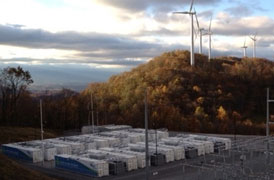Wind farms have been experimenting with using batteries to store energy, but this large one – online in West Virginia – proves it can be done … demonstrating that wind farms can produce electricity like traditional power plants.
The 98 megawatt (MW) Laurel Mountain wind facility is storing excess energy in a huge 32 MW bank of lithium-ion batteries developed by A123 Systems (Nasdaq: AONE).
61, 1.6 MW size turbines are connected to 16 mammoth batteries – each the size of a shipping container.

Each battery stores excess wind energy and releases it to the grid in quick bursts of 2 MW of energy for 15 minutes. The batteries release the energy to supplement intermittent wind generation, keeping electricity constantly supplied to the grid.
Project developer AES Energy Storage says it chose lithium batteries because they’re proven in the auto industry. Their use in that industry is bringing the price down, while size and performance is improving.
One of the most criticized aspects of solar and wind is that their inherent intermittency requires fossil fuel plants as back-ups, which raise the costs of operation, in addition to generating emissions. In this case, batteries replace the need for a back-up natural gas plant.
Next year, Duke Energy plans to deploy a 36 MW battery system at its 153 MW Notrees Windpower Project in Texas. Xtreme Power will supply the batteries, which also include sophisticated power control technology which enhances grid reliability.
The energy-storage industry is still in its infancy, but it’s forecast to be a $1.1 billion market by 2015, just for wind power. Beacon Power, which just declared bankruptcy, was developing flywheel technology to store energy, using a DOE loan guarantee.
While opponents point to the couple of failures of the DOE program – Solyndra and now Beacon – this is a success they won’t mention. DOE awarded a $25 million stimulus grant to
Southern California Edison to develop and conduct a comprehensive demonstration of lithium-ion battery storage for energy generated by wind projects. A123 supplied the lithium batteries.

 Loading...
Loading...
Batteries can fill a niche but where pumped storage and CAES are feasible, they may be a better option. For example, the proposed Mount Storm Pumped Storage project near the AES project described in the article would be able to provide 350 megawatts of power for 20 hours or more, at a far lower cost per megawatt-hour than batteries. And for Southern California Edison, four proposed pumped storage projects (two proposed by the same developer as Mount Storm) would provide similar capabilities. And the lifetime of each project would be 50+ years, versus perhaps 15 years (still unproven) for batteries. While it takes longer to develop, pumped storage has a much more versatile role to play. Few in the industry would disagree.
The missing cost ingredient says it all
Lithium batteries are a short term and limited solution to the variability problem of renewables. Also, lithium can only discharge down to 50% of charge or it greatly shortens the life of the battery. The cost per KwH is not financially viable taking into consideration all in capex and opex costs. Another thing no one mentions about Lithium or certain types of flow batteries is the safety issue. One run away with Lithium and the whole system becomes a bomb. With most types of flow batteries other than one, their chemistry is extremely hazardous as well. One death and it is game over for any one of these technologies. (Look at what happened to Nuclear)
Pumped Hydro and CAES are geographically limited and high cap ex.
What wind needs is distributed storage that competes on a cost basis with brown power with more than 6 hours of discharge. There is such a battery solution available.
The Technologies will lead us out of fossil dependancy, wind and solar, geothermal, electromagnetic. http://energyreviewsinfo.com